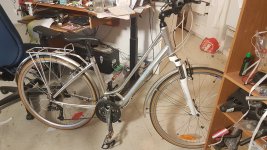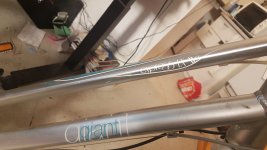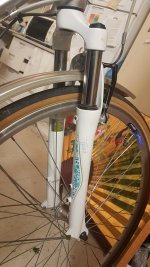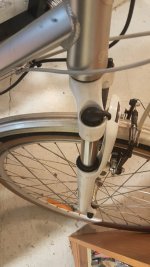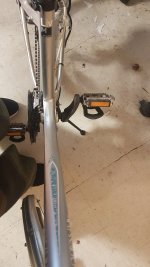sharinginfos
100 W
- Joined
- Sep 1, 2022
- Messages
- 172
HI i have this bike in aluminum my guess.
i could not confirm the drop outs but my mesurements give me 100 mm front and 12something in the back"can someone confirm this?
i need help to climb hills . i dont need speed on flat nor huge distances. i weight 160 and will carry cargo for camping. i can pedal but have a wouded knee.
at first glance i m looking for a front wheel motor since messing with rear involves cassettefreewheelchanginggears . would there be big advantages in placing the motor at rear ? i ask myself the question... but at first glace front wheel would be more simple.
battery (firesafe so lifepo4 only). Yes i know that 48 v is more polyvalent but i cannot find a way to buy or assemble one without spotwelding so I am atm looking at 24 volt used battery from batteryhookup
two or three of those in parrallel 24V 9.6ah 245.8wh K2 Lifepo4 Battery w/ BMS K2B24V10EB
so 20 or 30 amp .
what is the motor that has best climbing ability at 24v that fits 100 mm front fork?
i dont know a lot but a plus or minus friend told me to look at xiongda and Q series?
if you happen to know the draw of the motor you suggest, let me know it will help me choose the battery and controller for it.
i could not confirm the drop outs but my mesurements give me 100 mm front and 12something in the back"can someone confirm this?
i need help to climb hills . i dont need speed on flat nor huge distances. i weight 160 and will carry cargo for camping. i can pedal but have a wouded knee.
at first glance i m looking for a front wheel motor since messing with rear involves cassettefreewheelchanginggears . would there be big advantages in placing the motor at rear ? i ask myself the question... but at first glace front wheel would be more simple.
battery (firesafe so lifepo4 only). Yes i know that 48 v is more polyvalent but i cannot find a way to buy or assemble one without spotwelding so I am atm looking at 24 volt used battery from batteryhookup
two or three of those in parrallel 24V 9.6ah 245.8wh K2 Lifepo4 Battery w/ BMS K2B24V10EB
so 20 or 30 amp .
what is the motor that has best climbing ability at 24v that fits 100 mm front fork?
i dont know a lot but a plus or minus friend told me to look at xiongda and Q series?
if you happen to know the draw of the motor you suggest, let me know it will help me choose the battery and controller for it.


